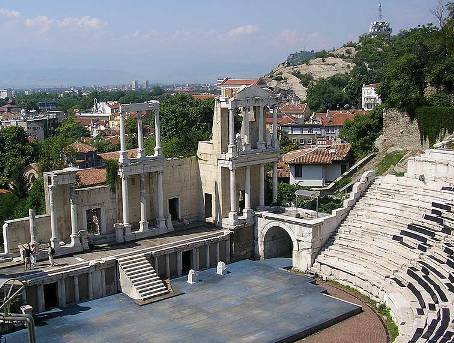

Location: Plovdiv
The Ancient Roman Theatre of Philippopolis, commonly known as the Plovdiv Roman Theatre or Ancient Theatre of Plovdiv (Bulgarian: Пловдивски античен театър), is one of the world's best-preserved ancient Roman theatres. Built in the 1st century AD during the Roman Empire, it exemplifies classical Roman architectural prowess and served as a central cultural and civic venue in the ancient city of Philippopolis (modern Plovdiv). With a capacity of 5,000 to 7,000 spectators, the semi-circular structure has been restored and continues to host performances, blending historical significance with modern utility. It is recognized as a symbol of Plovdiv's rich heritage, often hailed as one of Bulgaria's greatest conservation achievements, and stands as a testament to the region's Thracian, Roman, and Byzantine influences.
The theatre is situated in the heart of Plovdiv's Old Town, on the southern slope of the Three Hills (Trihalmieto), specifically in the natural saddle between Dzhambaz Tepe (Jambaz Hill) and Taksim Tepe. Its coordinates are approximately 42°08′49″N 24°45′04″E, offering panoramic views southward over the ancient lowland city and the Rhodope Mountains. This elevated position on a hill provided both aesthetic and acoustic advantages, integrating seamlessly with the urban landscape. Access is convenient: it's a 10-15 minute walk from Plovdiv's city center via streets like Tsanko Dyustabanov or Tsar Boris III Obedinitel Boulevard; by car, it's about 10 minutes from central areas; public buses (lines departing every 7 minutes from the south bus station) take around 15 minutes. The site is nestled within a historic district, near other Roman ruins like the Ancient Stadium of Philippopolis, making it a focal point for cultural exploration in Bulgaria's second-largest city.
The theatre's origins date to the late 1st century AD, likely constructed during the reign of Emperor Domitian (81-96 AD) or Trajan (98-117 AD), with inscriptions linking it to the governance of Titus Flavius Cotis, a high priest and heir to a Thracian royal dynasty who oversaw Philippopolis. Built on the site of earlier Thracian settlements, it reflects the Romanization of Thrace after the region's annexation in 46 AD. The structure thrived as a cultural hub until the 4th-5th centuries AD, when it suffered damage from fires, earthquakes, or invasions—possibly by Attila the Hun in the mid-5th century. Buried under 4.5-15 meters of earth from a landslide, it remained hidden for centuries until rediscovered in the late 1960s during archaeological excavations by the Plovdiv Archaeological Museum (1968-1979), prompted by a freak earthquake and construction work. The site was part of the broader Roman province of Thracia, serving not only entertainment but also civic functions like provincial assemblies. Its preservation highlights Bulgaria's archaeological heritage, with ongoing research revealing its multilayered history from Thracian roots to Roman grandeur.
Constructed primarily from brick, marble, and stone, the theatre follows the classic Roman design, semi-circular with an outer diameter of 82 meters. It was hollowed out of the hillside for natural support, divided into key sections: the cavea (seating area) with 28 concentric rows of marble seats in two tiers separated by a diazoma (aisle), accommodating wedge-shaped sectors (kerkides) via radial stairways; the orchestra, a horseshoe-shaped performance space 26.64 meters wide; and the scaenae frons (stage building), a three-story high wall with columns, a 3.16-meter-high proscenium decorated with Ionic colonnades and pediments. The facade features two-storey porticos in Ionic and Corinthian orders, with three symmetrical gates. Vaulted passages connect the cavea to the stage and external areas, including an underground tunnel beneath the stage for access. Safety features like barriers suggest adaptations for gladiatorial events. Honorary inscriptions on seats designated areas for elites, magistrates, and imperial associates. Restoration in the 1970s-1980s used the anastylosis method—reassembling original fragments with minimal new materials (marked for distinction)—ensuring authenticity while stabilizing the structure against seismic activity.
In antiquity, the theatre hosted theatrical performances, gladiatorial combats (evidenced by animal barriers during Emperor Caracalla's 214 AD visit), and civic gatherings, including sessions of the Thracian provincial assembly. It symbolized Roman cultural integration in Thrace, blending local traditions with imperial spectacles. Post-Roman decline led to abandonment, but its revival in the 20th century restored it as a venue. Key modern events include the 21st International Olympiad in Informatics prize ceremony (2009); live recordings like Devin Townsend's "Ocean Machine - Live at the Ancient Roman Theatre Plovdiv" (2018) with the Plovdiv Opera Orchestra; and Sons of Apollo's "Live with the Plovdiv Psychotic Symphony" (2019). It has also featured in cultural festivals, emphasizing its acoustics and ambiance for music and drama.
As of August 2025, the Ancient Roman Theatre remains a vibrant cultural landmark owned by Plovdiv Municipality, open to the public and hosting up to 3,500 spectators for summer events like plays, concerts, and festivals. It is fully restored, publicly accessible with a small entrance fee (around 5-10 leva or €2.50-5), and features multilingual informational panels, though guided tours are recommended for deeper insights. The site integrates into Plovdiv's tourism scene, with nearby cafes offering views of the Rhodopes. Recognized as a national monument, it attracts visitors for its historical value and modern utility, with ongoing maintenance ensuring preservation. No major structural changes have been reported recently, but it continues to promote tourism via unofficial sites and excursions, solidifying Plovdiv's status as Europe's oldest continuously inhabited city.